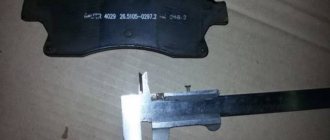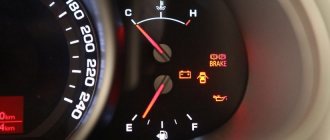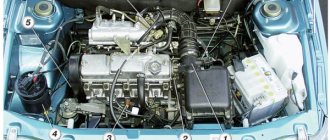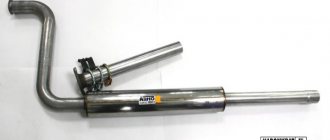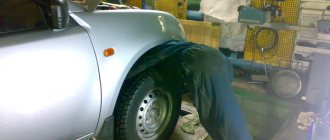26.12.2019
| (Votes: 2, Rating: 3.5) |
Issues discussed in the material:
- Why does the rear wheel get hot due to the brakes?
- How to avoid overheating brakes
- Why does the rear wheel hub get hot?
- What do car owners think about why the rear wheel gets hot?
When the rear wheel (one or both) gets hot, this does not bode well. The simplest reason is significantly exceeding the tire speed limit or driving with the handbrake. In this case, the consequences may be sad - up to the replacement of wheels, but at least the reason will be clear.
However, most often the root of the problem lies not on the surface. The wheel may overheat due to a malfunction of the brake system or problems with the wheel bearing. We will tell you how to find out the real reason and what to do next in our article.
Types of brake discs
There are several types of them. Discs differ in the material they are made of. The element can be made of cast iron, steel, cermet or carbon fiber. The last two types are high cost, and therefore are not used on most production cars.
Should brake discs get hot during operation? Yes, they should warm up. During braking, the pads clamp the disc on both sides. Due to the increase in friction force, the speed of the car decreases, and eventually the car stops. The kinetic energy arising at this moment is wasted to overcome friction and then turns into thermal energy. As a result, the disc and pads heat up. You need to understand that this is a completely normal phenomenon. But the heating should not be excessive. It is not the process itself that is important, but the deformation of the disc after it. During prolonged braking (for example, on mountain serpentines), the system components can overheat greatly, which can cause warping and then beating when pressing the pedal. If you drive into a puddle with an overheated disk, then due to sudden temperature changes the metal may completely crack.
Metal ceramics and carbon fiber can heat up to 1200-1400 degrees, and this is quite normal for these materials. The coefficient of friction is higher here, but these materials are not so susceptible to thermal deformation. For metal disks, the maximum heating temperature is 500-600 degrees. Overheating will lead to loss of geometric characteristics.
How to eliminate heating
In practice, several methods are considered to avoid unfavorable situations. Regular technical inspection of a car was not invented by reinsurers, but by professional specialists as a result of research and calculations. To avoid problems, you need to avoid aggressive driving. After all, metal can heat up faster than it can cool down.
It is also recommended to change the pads in a timely manner - after covering the designated mileage or if excessive overheating of the products is suspected. Next, it will become clear why the rims on the wheels of the car get so hot.
Every manufacturer advises avoiding purchasing low-quality products. By installing worn-out components on your car, you can attract adverse consequences. In addition, it is not recommended to drive the vehicle at high speed.
The main reasons for overheating of brake discs
Among the main reasons are jamming brake caliper guides. In this case, the pad cannot evenly clamp the working surface of the disc.
Also, the latter can heat up due to deformation - the block presses unevenly on the working plane. Another reason is natural wear of the pads. Also, different brakes on the front and rear axles lead to overheating.
Brake fluid
On older cars, the system was mechanically driven. Over time, manufacturers began to equip cars with more advanced systems. Nowadays hydraulics are used to drive the brakes. The use of such a drive made it possible to reduce the efforts that must be made to reduce speed. At the same time, the braking process itself has become more efficient due to the use of brake fluid.
It moves along the highways and puts pressure on the working cylinders, creating the necessary force to press the pads. Like all technical fluids, brake fluids have their own lifespan. Few people know about this, but it is true. And the operation of the cylinders in the caliper depends on the condition and characteristics of this fluid.
Automotive service experts recommend changing brake fluid once every two years. Why exactly this period? It's all about hygroscopicity. The fluid absorbs moisture, and the latter destroys parts of the brake system. Due to corrosion, the brake system piston cannot effectively press the pads. Situations often occur when the pistons jam in any one position.
The pad will constantly touch the disc. As a result, the latter will heat up. This is why brake discs get hot after replacing the pads. Old, erased elements did not reach the surface of the disk. And the new ones have a thicker friction lining. Hence the friction.
What is the repair method? The situation can be corrected by regularly replacing the brake fluid. This will avoid corrosion in the lines and system elements.
What do car owners think about why the rear wheel gets hot?
- The rear wheel is heating up - a bearing or pad problem “I learned a long time ago why the rear wheels are heating up. So, if the wear of the pads on both wheels is the same, then wedging of the caliper can be ruled out. All that remains is the wheel bearing. He begins to die slowly, so he doesn’t always show signs, but from time to time.”
- If the rear pad gets hot, you need to check the handbrake
“If the disc/drum does not heat up when the handbrake is raised, the handbrake does not function. And the harder the handbrake is applied, the more the rear wheel heats up.The quality of the pads can be checked through the operation of the same handbrake. According to the rules, he must maintain a slope of 32 degrees.”
- If the drums are at the back
“If the rear shoe heats up due to poor adjustment of the gaps in the drum, this problem must be eliminated and corrected. 5 minutes to do.”We recommend
“What do the dots on tires mean” Read more
- When the pad heats up, the handbrake cable needs to be adjusted.
“Check the handbrake cable. To do this, you need to remove it, hang it vertically and pour the cable itself (not the jacket on top, but the cable itself, you need to pour it directly inside the cable) with ordinary oil. Try to move him with your hands; if he walks without hesitation, you can put him back and try to loosen the tension.” - If the rear wheel gets hot, sometimes you just need to clean it
“I discovered that my rear left one was getting hot, the dealer asked for 1,200 rubles. for “cleaning”, I sent it through the forest, cleaned it myself with a beer in 20 minutes - everything was gone, now both rear wheels are a little warm after normal driving and do not heat up like before.”
Human factor
Every year the weight of cars increases, and the power of the power unit also increases. Car owners put pressure on the accelerator and do not think about how the system functions. But all you need to do is remember the physics course at school. If the resistance increases, the friction force also increases. The same applies to brake discs. To reduce speed on a car weighing 1.5 tons, a lot of compression force must be applied to the pads.
The temperature of the disc is rising, and if you add to this an aggressive driving style, the heating is easy to explain. Do not put too much stress on the brake system by frequently pressing the pedal. This will not have the best effect on the life of the pads and disc. This is especially true for budget class cars with small calipers.
How the malfunction manifests itself
The malfunction, which results in intense heating of the brake disc, manifests itself as a characteristic metallic squeak from friction between metals. As a rule, one brake pad begins to jam, so the brake disc on one side overheats.
Curvature of the front discs, since they are the ones that most often suffer from such a defect, is accompanied, in addition to overheating, by a beating in the steering wheel when driving.
Severe wear of linings and discs (below the minimum permissible values) is manifested in a deterioration in their braking qualities and an increase in the distance required to stop the car. In addition, it may be accompanied by a squeak from the contact of the metal part of the pad with the disc shoulder and a decrease in the level of brake fluid in the master cylinder reservoir.
Stopping support
If the brake discs get very hot after replacing the pads, then you should carefully examine this element. The caliper may simply jam. In this case, the pad will not evenly adhere to the surface of the disc. Due to this, the friction coefficient increases. You should also make sure that the caliper guides are well lubricated. If there is no lubricant, it is necessary to treat each guide and the entire caliper mechanism with it. When driving a car with worn brake pads, the system piston may come out of the cylinder higher than normal. The mirror in the place where the piston should be will oxidize or become damaged. Once new pads are installed, the element will not return to its normal position. This problem can be solved by replacing the caliper repair kit. It is also recommended to check the condition of the anthers. If cracks appear in them, they should be replaced. Dust and dirt are one of the reasons for a stuck caliper.
Incorrect installation of components or poor quality parts
It is quite possible that excessive heating of the brakes is due to the fact that the equipment was assembled incorrectly at the service center. In this case, you will have to completely disassemble the system and check the quality of its assembly. And this must be done as soon as possible. In the best case, you will be able to reassemble everything correctly and just drive the car without any problems. In the worst situation, you will have to disassemble and reassemble the device several times to find the real problem.
Problems arise for the following reasons:
- an incorrectly assembled mechanism does not return the pads back, so that when the brake pedal is pressed, the pads remain in the spread position and continue to slow down for some time;
- a dropped or not put on spring for adjusting the brake pads gives a similar effect; the elements are brought together only if you sharply release the brake pedal, and the adjustment will be incomplete;
- purchased low-quality spare parts can cause such problems - the parts may be too large, a 1-2 mm misalignment in size is enough to cause constant friction;
- a thick lining can also cause strong heating, in this case you purchased defective pads, they should be replaced, and not modified or sawed off their parts;
- Perhaps one of the parts of the brake mechanism has failed, rusted or become very dirty; this may well cause the unpleasant moments described in the article.
You shouldn’t disassemble the brake drum yourself unless you have experience and sufficient confidence that you can put everything back in place efficiently. It should be borne in mind that the braking process must work very well, so subsequent disassembly and reassembly of the brakes should be entrusted to specialists at a proven station. If you don't have one, it's worth asking other drivers of cars like yours. Perhaps they will suggest you a good service station or even a garage mechanic with golden hands and a low price tag for the job.
Disk Status
If the disc heats up after replacing the pads, the reasons for this phenomenon may be related to the disc itself. The latter has a shoulder on the working surface. Where does it come from? It was wiped by the old pads, and after installing the new ones, they rub against this shoulder. This is the reason. Repair method: grooving the brake disc. But it is done when the residual thickness of the element is not lower than normal and there are no cracks on the surface.
Rules for rolling in new pads
After replacing them at car repair shops, mechanics often forget or simply do not tell clients about the rules for operating a car with new pads. For approximately 200-300 kilometers, it is recommended to avoid emergency and extreme reduction in speed.
During this period, the friction lining rubs against the surface of the disc. Immediately after replacement, braking efficiency decreases. The driver presses the pedal harder. This is the reason why the front brake discs heat up after replacing the pads. But with “grinding in” the problem goes away by itself.
Handbrake cable - the eternal problem of drums
The rear brake performs not only dynamic braking functions. He also plays the role of a handbrake. Separate cable systems are responsible for this, which tighten the pads and release them when the handbrake is released. In this case, the system does not depend on the brake fluid and is driven mechanically by raising the handbrake lever in the cabin. The cables themselves tend to rust and jam, and they can also move poorly through grooves and holes, creating problems for the car owner.
You can check this as follows:
- select a section of the road where there is a very slight slope, do not turn off the car, release the brake pedal and do not touch the handbrake, record how fast the car rolls;
- then stand in the same place and fully tighten the handbrake, check whether the car is not rolling in this position, it should stand confidently and without the slightest attempt to move down the hill;
- then release the brake pedal, sharply release the handbrake completely and see how the car behaves, in this case you can see how quickly the pads close;
- if the car first stood still and then began to move with a grinding noise, there is a problem in the pad reduction mechanism, which must be repaired for normal driving;
- If the car is left standing still, then the culprit for heating the drum while driving is most likely jammed handbrake cables; they need to be replaced along with all fasteners.
When replacing the handbrake cables, do not forget to change the two working and central cables. The system will be different in each car, but in general the equipment will be similar. Again, you shouldn’t change the cables yourself. This can lead to unpredictable consequences. You can independently repair parts of the braking system if you have sufficient experience and can efficiently assemble the equipment without referring to various reference books and manuals.





